The latest release from Atomic Mass Games features two new characters for the game, both of whom it’s fair to say are not in the A-tier of recognizable Marvel characters. Additionally, the box contains several new Team Tactics Cards for the Defenders Affiliation. How do these new characters and cards stack up?
Silver Sable
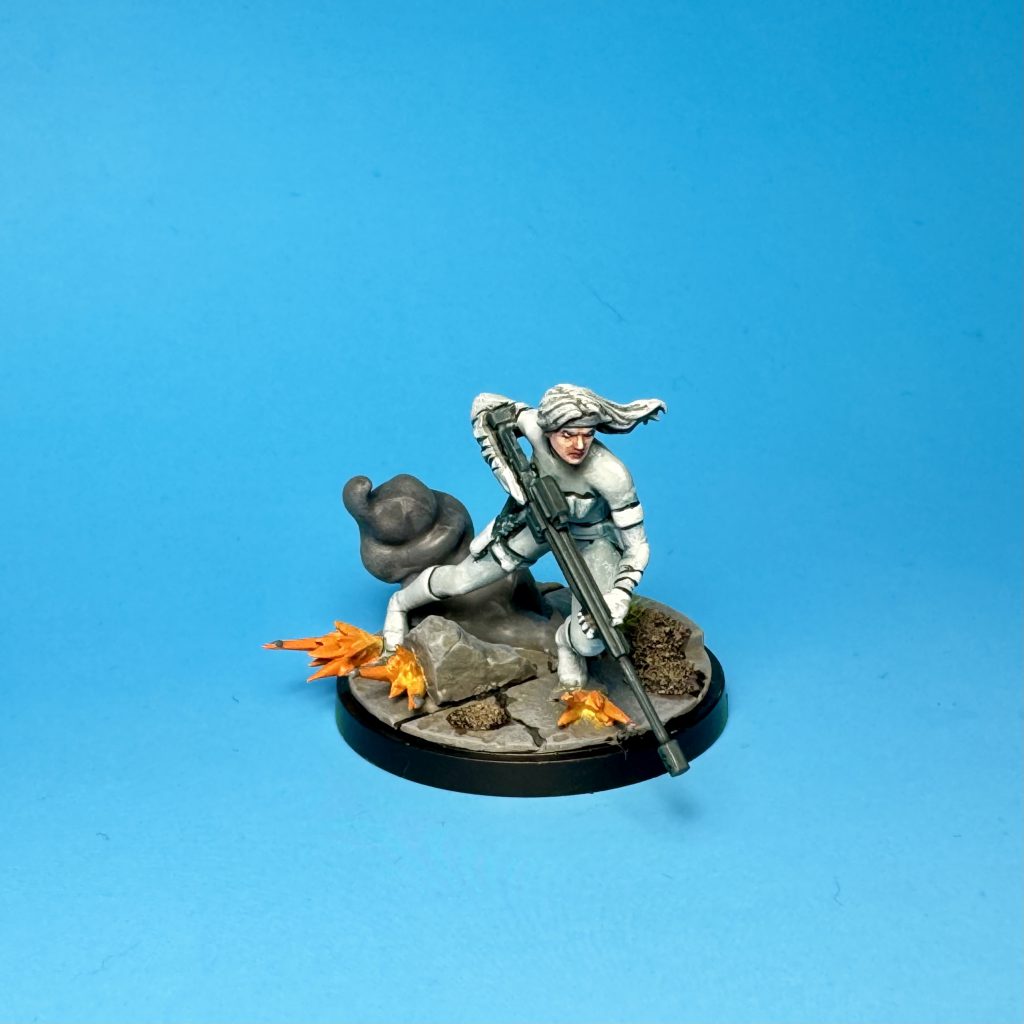
Silver Sable, whose real name is Silvija Sablinova, is a Marvel Comics character who first appeared in The Amazing Spider-Man #265 in 1985. Sable is a skilled martial artist and markswoman, often involved in espionage and mercenary work. Though she operates in a morally gray area, she often aligns herself with heroes to combat greater threats. She has been both a deadly adversary and romantic interest of Spider-Man in particular.

At first glance, Silver Sable’s stats look unimpressive for a 4 threat model. A 3/3/3 defensive line with 5 health (6 on her injured side) is normally not enough for the cost. However, these stats are clearly meant to balance with her Sniper Nest rule. (More on this below.) Her Medium move and Size 2 are standard for a model representing a ‘normal’ human, with Wall Crawler giving her the mobility to get into those terrain nests.
Sable’s gainer attack is a solid Range 5, Strength 5 physical rifle shot that gives her 1 energy after the attack is resolved. Additionally, with a little luck she can Root the target and push the target toward her, potentially pulling models off objectives or setting them up to be attacked by her teammates. Her spender, ‘Headshot’, is an interesting new design space for the game. It’s relatively inexpensive at 3 energy (though in practice effectively costs 5, see below), has the same Range 5 as her gainer, and a Strength of 6. If the model is more than Range 3 from Sable, not benefitting from Cover, and would suffer damage, the damage amount is increased by 2. This is the first time we’ve seen a straight damage buff like this on an attack. It has a great deal of conditions to get it to work, but getting a consistent buff to damage instead of additional dice is a substantial benefit in a high-variance opposed dice game like this.
Silver Sable’s superpowers accurately represent her skills as a tactician and mercenary leader. ‘Shot Caller’ lets an allied character within Range 4 of Sable make a Short advance during her activation, and gain 1 energy to boot. This can be a killer way to set up models like Wolverine to do his signature ‘charge and go ham’ move. I’m sure more skilled players will come up with all kinds of interesting combos that take advantage of this rule. Definite potential here as an interesting, high skill cap rule.
‘Want My Help? Pay Up’ is interesting as well. Another allied model with Range 4 of Silver Sable can pay 2 energy when making an attack. Sable then gains 1 energy, and the model who paid adds 1 die to its attack roll. It’s once per turn, so the whole team can take advantage of this theoretically. If they have the energy to spare, an extra die is always nice especially when fishing for Wild and Critical effects. This also helps with Sable’s poor energy generation. Interestingly, the rule is clearly worded to allow Sable to use it. Since it reads “an allied character within R4” and not “another allied character within R4”, Sable can declare the attack, pay 2 energy, get 1 energy back immediately, and add 1 die to the attack roll. If you’re looking to pop off with her spender and ensure some damage, you better make sure you have 5 energy to pay for the attack and superpower. (You’ll get 1 back immediately, but still need 5 energy to get it going.)
Finally, that ‘Sniper Nest’ rule: if she’s camped on Size 3 or larger terrain, Silver Sable adds two dice to physical and energy defense rolls as long as the attacker is not also on the same terrain piece. That’s a solid bump, but is heavily dependent on terrain placement. Additionally, in a game designed around hurling large terrain objects at one another, that nest of hers can disappear in a hurry.
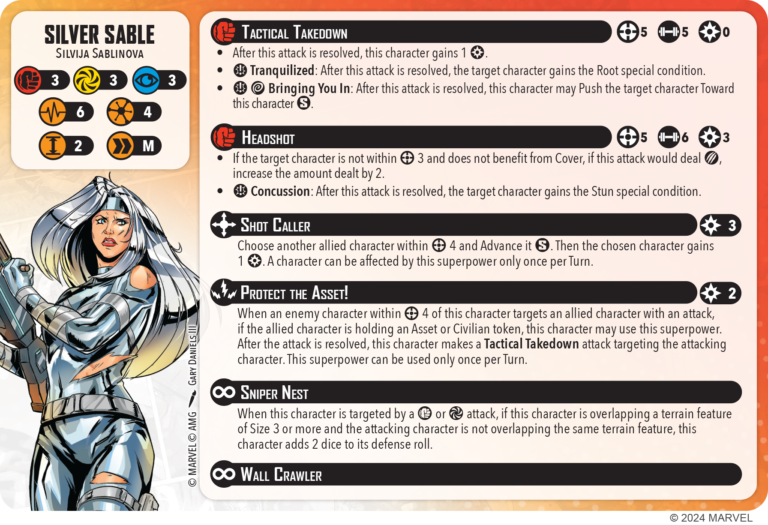
When Silver Sable flips to her Injured side, she goes from 5 to 6 health and substitutes a new superpower, ‘Protect The Asset!’ in place of the ‘Want My Help? Pay Up’ rule. If an enemy within Range 4 attacks an ally holding an Asset or Civilian extract, Sable can pay 2 energy to use her ‘Tactical Takedown’ gainer targeting that enemy, after the enemy’s attack is resolved. Ironically, this new rule also costs 2 but refunds 1 energy once she resolves her attack, similar to the rule it replaced. Out of activation attacks, especially those that can displace enemy models, are always valuable. But I feel this will have niche utility at best in most situations as Sable will often be starved for energy and wanting to save it for ‘Headshot’ when possible.
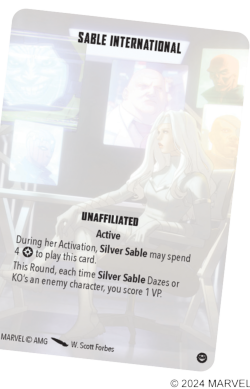
Silver Sable gets one TTC reflecting the mercenary company she runs. For 4 energy, she can play this card during her activation. For the remainder of the round, any time she Dazes or KOs an enemy character, you score 1 VP. Theoretically, that could be a game winner in late rounds. In practice, she’s going to have a hard time generating enough energy to pull off paying for this card and doing her spender attack she’d clearly want in that situation. Hypothetically she can use ‘Protect the Asset’ later in the round also. But again, she’s probably depleted all her energy after her activation. In practice this card can probably get you 1 VP if the dice go your way, maybe 2. Is it worth a valuable card slot in your 10 (let alone the 5 you take in game)? Probably not.
As far as roster building goes, Silver Sable doesn’t fit with Defenders nearly as well as her companion Shang-Chi. Daredevil-led Defenders want to be up close and personal with close scenarios on E maps and the like. Silver Sable wants to hug a back point and snipe fools, and never wants to be up close. I like to have one long range shooter and objective holder available in my Defenders roster, but Sable doesn’t cut it when I can take Hawkeye instead. He’s cheaper, easily tosses out status effects, can swap between physical and energy attacks, and has enough power to be mobile and annoying all game. I like him as a Patch-Up source with all that power and mobility also. Finally, Hawkeye makes for an excellent counter to our next featured model ironically enough. Silver Sable will likely see play in any other affiliations she’s added to (unknown at time of writing), but I’m not sold on her as a Defender.
Shang-Chi
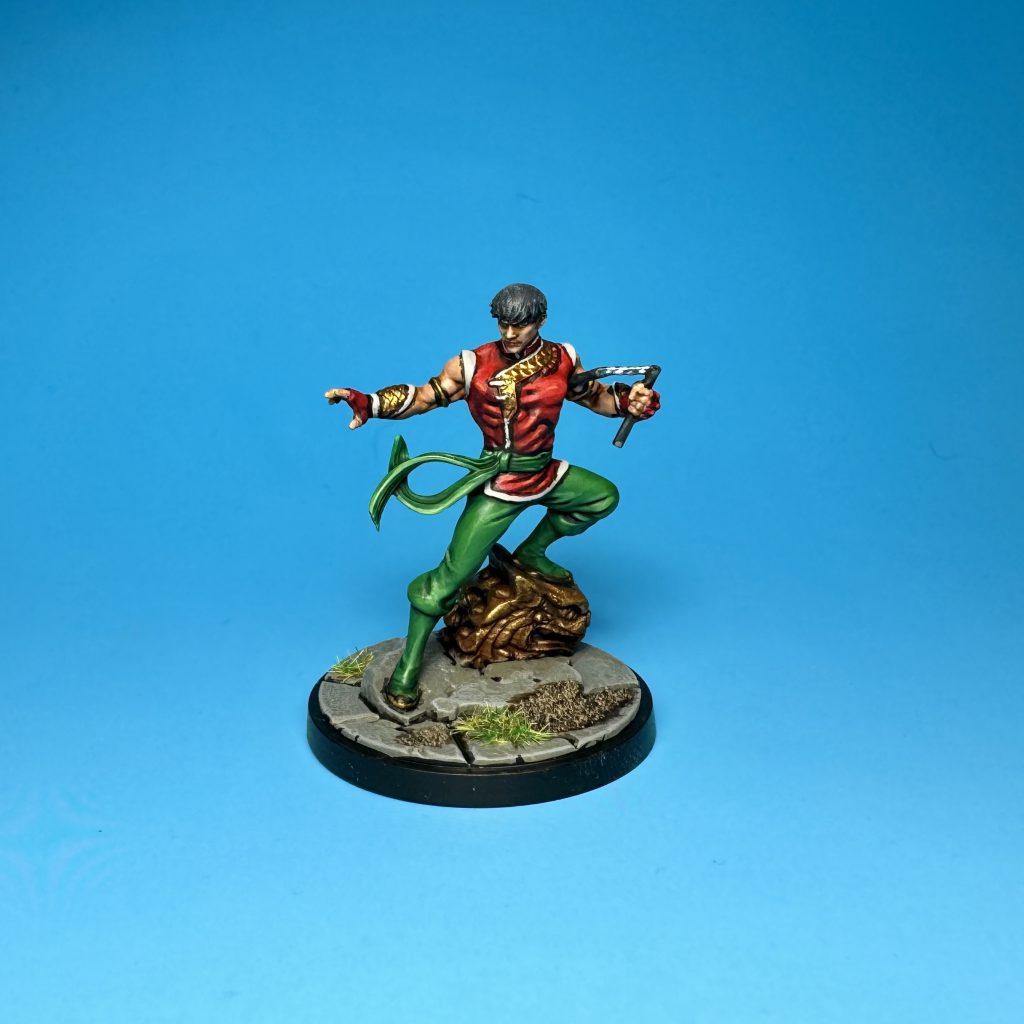
Zheng Shang-Chi first appeared in Special Marvel Edition #15 in 1973. He is the son of a criminal and villain, who he eventually rejects to fight for justice. Shang-Chi is a highly skilled martial artist, considered one of the greatest hand-to-hand combatants in the Marvel Universe. He often employs his abilities in solo adventures and as a member of teams such as the Avengers and Heroes for Hire. His character blends traditional martial arts themes with modern superhero elements, emphasizing his journey from his father’s shadow to becoming a hero in his own right.
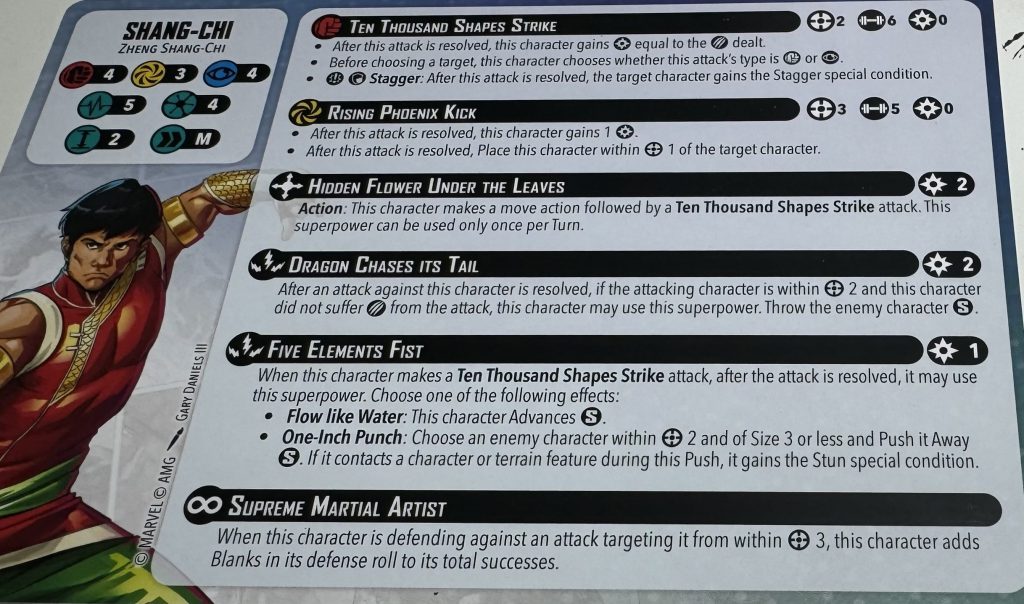
Shang-Chi also clocks in at 4 threat, with solid 4/3/4 defenses, and the standard Size 2 and Medium move. His low 5 health (6 when Injured) is identical to Silver Sable’s, but his emphasis on short ranged attacks make him more fragile. Still, he has a whole menu of tricks to stay safe and disrupt his enemies. And what a menu, by the way- his attacks and superpowers all have amazing names inspired by the classic kung fu movies that inspired the character. Just getting to say all the names during games makes him a fun character to play!
Shang-Chi has no spender attack on his Healthy side, but both of his attacks here are solid and have a great deal of utility. ‘Ten Thousand Shapes Strike’ is a Range 2, 6 dice physical gainer attack which can be made physical or mystic, an uncommon option in MCP. Additionally, if he rolls both a Crit and a Shield, the target character is Staggered. That’s a somewhat tough trigger, but with access to Defender or other rerolls, he’s got a decent shot at really hurting the opponent’s action economy. Skipping ahead to his superpowers, once per turn Shang-Chi can pay 2 energy for ‘Hidden Flower Under The Leaves’ and move plus attack with this. Action economy is everything in MCP, and Shang-Chi can simultaneously improve his own and hurt his opponent’s. Absolute banger of a card so far, but we’re not even done with his most basic attack.
If all that wasn’t enough, following a ‘Ten Thousand Shapes Strike’, Shang-Chi can pay 1 power for an additional effect courtesy of ‘Five Elements Fist’: either allowing him to make a Small Advance with ‘Flow Like Water’, or push a nearby model a Small distance Away with a ‘One-Inch Punch’. . It need not be the model he targeted with his attack, and they even gain Stun if they bump into something. This kind of tool chest will win savvy players games with a key Advance or Push at the right time.
‘Rising Phoenix Kick’ is less of a tool chest, but it’s still a Range 3 Strength 5 gainer that places Shang-Chi near his target after the attack is resolved. (That’s important to note, as likely won’t get a re-roll from his target, but might from any enemies nearby before he does his kick.) Nothing amazing, but the effective free move can be very useful for getting him to where you want him. It’s also worth noting it’s an energy attack, meaning when he’s Healthy, Shang-Chi has access to all three attack types.
The remaining powers on this side of his card are no slouches, either. ‘Dragon Chases Its Tail’ is situational, but if an opponent character fails to wound him with a close-range attack, it could absolutely be worth the 2 power to throw said model. Finally, ‘Supreme Martial Artist’ means Shang-Chi counts Blanks in all defense rolls when the attacker is within Range 3, including against mystic attack. That helps shore up his defenses for sure, but still watch that 5 health!
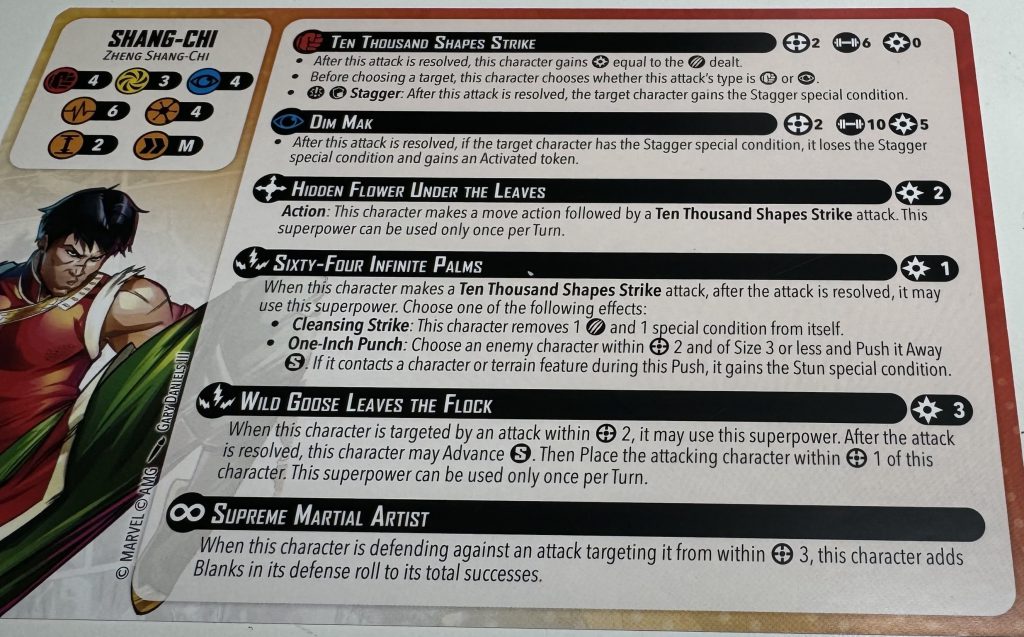
Our boy Shang-Chi really gets dangerous once he’s Injured. He loses his flying kick, but gains the brutal ‘Dim Mak’ spender attack. It’s expensive (5 power) and a short Range 2, but it’s a 10 dice mystic attack that can force a model to lose its activation that turn if it’s already been Staggered. Conveniently, Shang-Chi has access to a very good attack for doing just that. And of course, nothing says another model can’t throw off the Stagger, either.
The Injured side retains his ‘ Hidden Flower Under The Leaves’ charge ability and ‘Supreme Martial Artist’, but instead of his throw reactive, he now has ‘Wild Goose Leaves The Flock’. This one is pricy and situational but it can force opponent’s attacking models way out of position, and/or Shang-Chi himself into better positions. Another niche but potentially powerful rule.
Finally, getting Injured supercharges Shang-Chi’s punches, turning his ‘Five Elements Fist’ into ‘Sixty-Four Infinite Palms’. (Seriously these names are so good.) As before, this lets him pay 1 power for an additional effect after doing a ‘Ten Thousand Shapes Strike’ attack. The ‘One-Inch Punch’ remains, but instead of the previous Advance effect, he now has ‘Cleansing Strike’ which lets Shang-Chi remove 1 damage and 1 special condition. With the extra health on his Injured side, this rule can help him last just a little longer on the field.
What about his Team Tactics Cards you say?
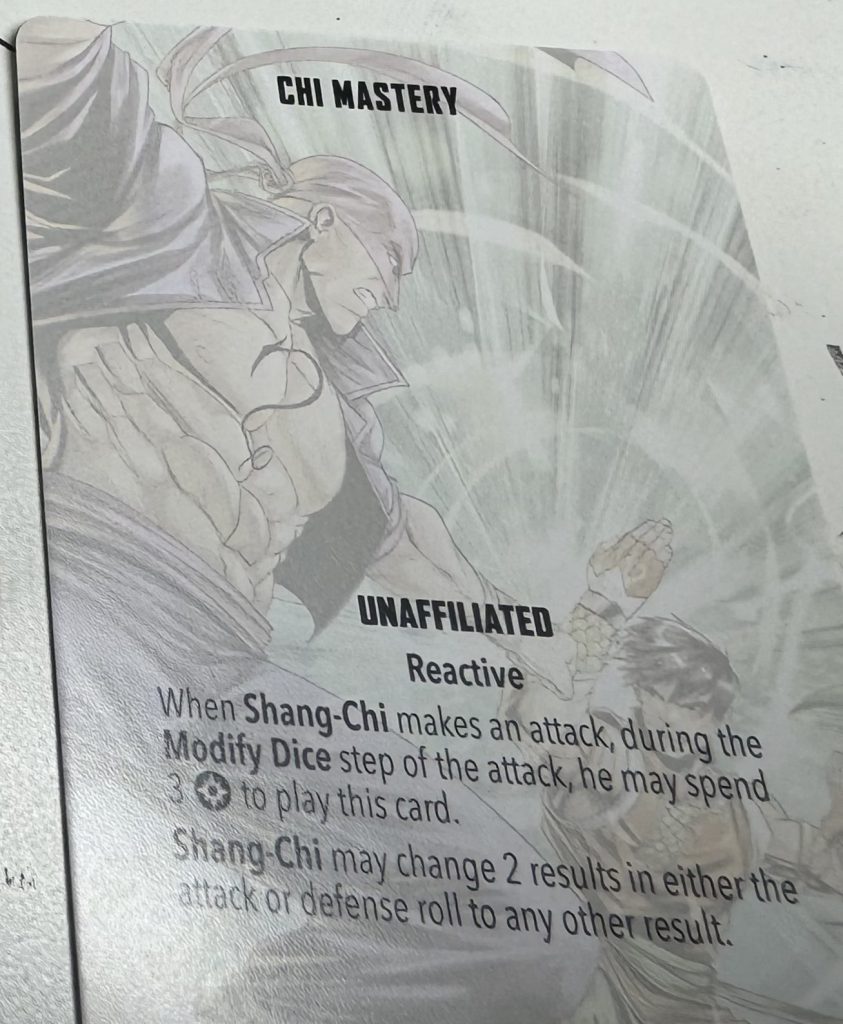
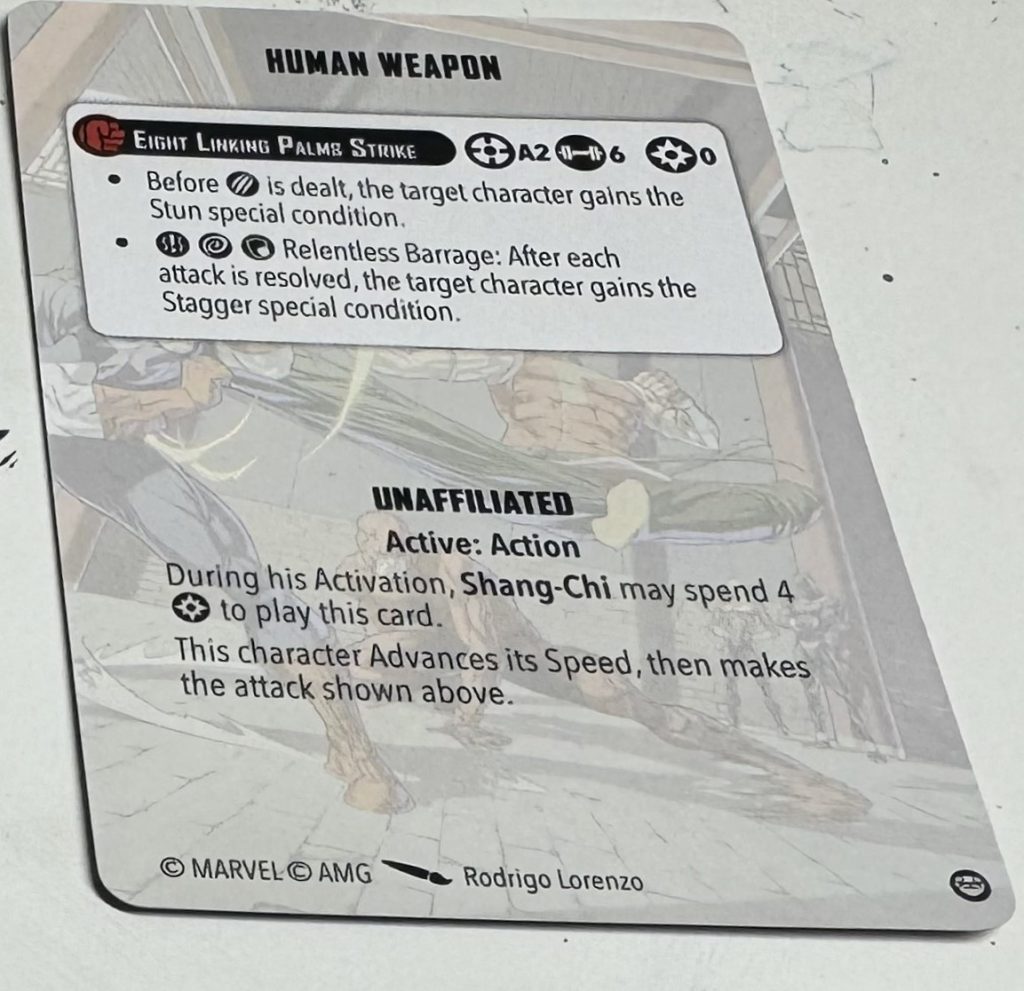
Human Weapon gives access to a unique attack. For 4 power, Shang-Chi gets to advance, then does an A2 range, 6 Strength attack that Stuns before damage is dealt, and if he’s very lucky, will cause some Staggers. This can be cute in the right scenario, including the scenarios Daredevil Defenders like to see. And the extra movement is always a boon. But even with re-rolls this card probably isn’t worth the hefty price tag of 4 power and a card slot. Chi Mastery is a fun, characterful card that allows for very powerful dice manipulation. He can guarantee a Stagger off his builder, or turn off opponent defense successes. Guaranteeing anything in this game is very powerful, so this card can certainly be useful. Does it beat out other power cards in Defenders or elsewhere? I’m not convinced.
Shang-Chi is likely to show up all over the place after he first hits the scene. He’s definitely worth a spot with Defenders, and will have game in any other affiliations he gets added to. Even if he’s not, I can see an argument for splashing in affiliations like Web Warriors and Avengers, even Emo Daredevil’s Criminal Syndicate among others. I’m personally interested in trying him with all three Captain America leaderships.
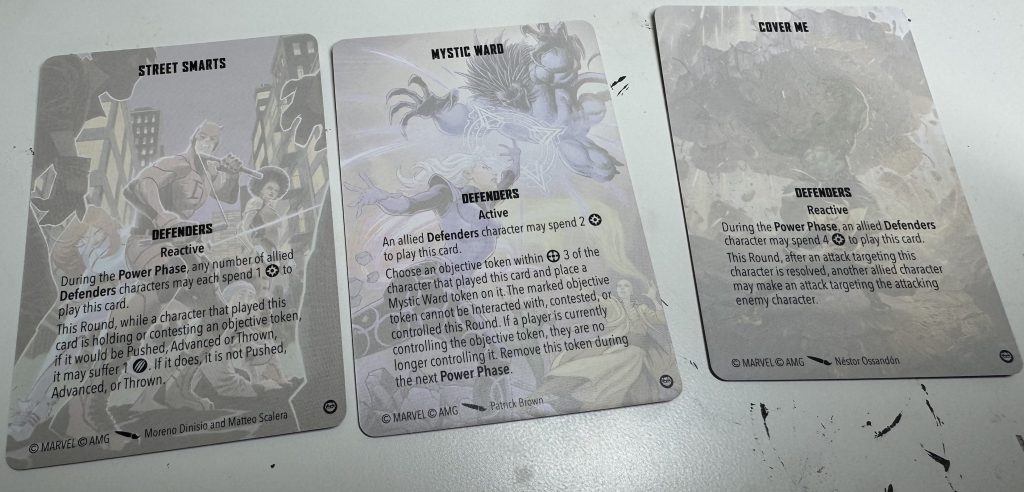
Defenders players rejoice, because you now have viable Team Tactics Cards. Street Smarts will allow Defenders characters to pay 1 power and ignore a Push, Advance, or Throw at the cost of 1 damage each time. This one might have some play, but knowing when to use it will be key. You don’t want chip damage like this to lead to your key models being Dazed or KO’d at a key moment. Mystic Ward is a definite banger and will probably be stapled to my Defenders roster. For 2 power and this card, a Defender can just…turn off an objective token with Range 3. You’re most likely to use this to shut down an opponent scoring a big VP swing, but there are niche benefits like turning off certain abilities that key off being near objectives. I think this has play as a Turn 1 move to get an early lead, or stop your opponent scoring on scenarios like Research Station that can snowball very quickly. Defenders even have multiple models that can pay for it on Turn 1, such as Iron Fist and Valkyrie. Finally, Cover Me is a cute card that will force your opponent to think carefully about attacking a key model. I think there are enough ways to play around it though, and it’s pricey. I don’t see it worth a slot in my Defenders roster, but am happy to be proven wrong by others for sure.
Conclusions
This is a solid expansion box with some quality models and TTC for Defenders players in particular. The models are also easily splashed into many other factions as well. Shang-Chi in particular has a solid sculpt that’s fun to paint. This is a worthwhile purchase for just about any Marvel: Crisis Protocol player. Where do you think these models will see play? Let us know in the comments!


